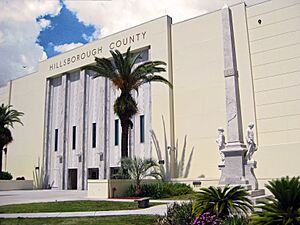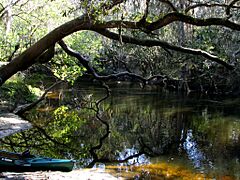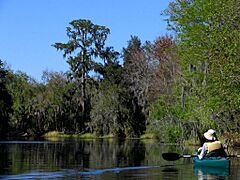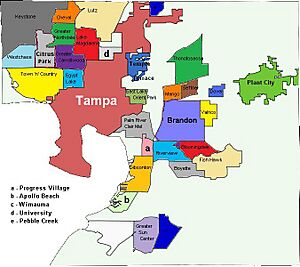Hillsborough County, Florida facts for kids
Quick facts for kids
Hillsborough County
|
|||||
|---|---|---|---|---|---|
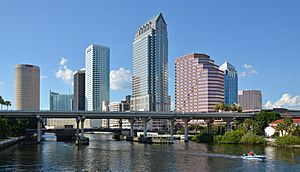
Downtown Tampa skyline
|
|||||
|
|||||

Location within the U.S. state of Florida
|
|||||
 Florida's location within the U.S. |
|||||
| Country | |||||
| State | |||||
| Founded | January 25, 1834 | ||||
| Named for | Wills Hill, Earl of Hillsborough | ||||
| Seat | Tampa | ||||
| Largest city | Tampa | ||||
| Area | |||||
| • Total | 1,266 sq mi (3,280 km2) | ||||
| • Land | 1,020 sq mi (2,600 km2) | ||||
| • Water | 246 sq mi (640 km2) 19.4%% | ||||
| Population
(2020)
|
|||||
| • Total | 1,459,762 | ||||
| • Density | 1,431/sq mi (553/km2) | ||||
| Time zone | UTC−5 (Eastern) | ||||
| • Summer (DST) | UTC−4 (EDT) | ||||
| Congressional districts | 14th, 15th, 16th | ||||
Hillsborough County is a large area in the middle of Florida's west coast. It's home to many people, with over 1.4 million living there in 2020. This makes it the fourth most populated county in Florida. The biggest city and the main center of the county is Tampa. Hillsborough County is part of a larger area called the Tampa Bay Metropolitan Statistical Area, which includes cities like St. Petersburg and Clearwater.
Contents
- History of Hillsborough County
- Geography and Nature
- Population and People
- Economy and Jobs
- Education in Hillsborough County
- Museums and Libraries
- Local Agencies and Public Safety
- Hillsborough County Fire Rescue
- Transportation in Hillsborough County
- Protected Natural Areas
- Parks and Recreation
- Cities and Communities
- See also
History of Hillsborough County
Hillsborough County was created a long time ago, on January 25, 1834. This was when Florida was still a U.S. territory, before it became a state. The county was named after Wills Hill, who was the Earl of Hillsborough in Great Britain. He was a British official from 1768 to 1772.
When it was first formed, Hillsborough County was much bigger than it is today. It included parts of eight other counties that exist now, like Manatee and Pinellas. The last big change to its borders happened in 1911, when Pinellas County was created from its western part.
A cool historical fact: on New Year's Day in 1914, the world's first scheduled commercial airline flight took off from St. Petersburg and landed in Tampa. This was a big step for air travel!
Geography and Nature
Hillsborough County covers a total area of about 1,266 square miles (3,279 square kilometers). Most of this is land (about 1,020 square miles or 2,642 square kilometers), but a good portion is water (about 246 square miles or 637 square kilometers).
The county has a long shoreline on Tampa Bay, stretching for about 158 miles (255 kilometers). Even though it's mostly landlocked, a small part of Hillsborough County reaches out to the Gulf of Mexico. This narrow strip of water includes the middle part of the Sunshine Skyway Bridge and Egmont Key, which is at the entrance to Tampa Bay.
Hillsborough County is home to beautiful natural areas. You can find Alafia River State Park and Hillsborough River State Park here. There are also important water sources like the C. W. Bill Young Regional Reservoir and Lithia Springs Regional Park, which has one of Florida's largest natural springs.
-
On the Alafia River near Lithia Springs Park
-
An alligator in the Alafia River State Park
-
On the Hillsborough River near Lettuce Lake Park
Neighboring Counties
Hillsborough County shares its borders with these other counties:
- Pasco County – to the north
- Polk County – to the east
- Manatee County – to the south
- Pinellas County – to the west
- Hardee County – to the southeast
Population and People
Hillsborough County has grown a lot over the years. In 1840, only 452 people lived here. By 2020, the population had jumped to 1,459,762 people. This makes it one of the fastest-growing areas in Florida.
The county is a diverse place, with people from many different backgrounds. The population includes a mix of White, Black or African American, Asian, Native American, and multiracial people. A significant part of the population is also of Hispanic or Latino origin.
In 2020, there were 1,459,762 people living in the county, with over 539,000 households. The average household had about 2.55 people. About 23.9% of the population was under 18 years old.
Most people in Hillsborough County speak English at home (about 74.59%). Spanish is the second most common language, spoken by about 19.52% of the population. Other languages like French Creole and Vietnamese are also spoken.
Economy and Jobs
Long ago, in the early 1900s, Hillsborough County's economy was mostly about making cigars and farming. Today, farming is still very important. In 2012, Hillsborough County had the second-largest amount of farm products sold in Florida.
Many people work in different industries here. Some of the main job areas include:
- Trade, transportation, and utilities (like shipping and stores)
- Professional and business services (like accounting and marketing)
- Education and health services (like schools and hospitals)
- Financial activities (like banks)
- Leisure and hospitality (like hotels and restaurants)
Farming in Hillsborough County
Farming is a big deal in Hillsborough County. In 2011, farmers sold over $832 million worth of agricultural products! The most valuable crop by far was strawberries, bringing in over $388 million. Other important farm products include vegetables, ornamental plants (like flowers and shrubs), and citrus fruits.
| Crop | Sales in dollars | Acreage |
|---|---|---|
| Strawberries | $388,125,702 | 11,625 |
| Vegetables | $150,000,000 | 13,092 |
| Ornamental plants | $139,232,407 | 3,977 |
| Aquaculture | $23,546,112 | 876 |
| Beef cattle/pasture | $18,934,207 | 91,904 |
| Citrus | $18,893,572 | 10,750 |
| Poultry | $18,701,100 | 22 |
| Sod | $7,438,855 | 2,286 |
| Dairy | $6,433,206 | 1,500 |
| Blueberries | $5,500,000 | 591 |
| Hay | $2,374,195 | 635 |
| Forestry | $1,000,000 | 108,634 |
| Bees/honey | $598,767 | 45 |
| Goats | $154,177 | 518 |
| Miscellaneous | $51,478,000 | 3677 |
| Total | $832,410,300 | 255,532 |
Companies with Headquarters in Hillsborough County
Many well-known companies have their main offices in Hillsborough County. Some of these include:
- Beef O'Brady's Restaurants
- Big Brothers Big Sisters of America (a non-profit organization)
- Bloomin' Brands Restaurants (like Outback Steakhouse)
- Checkers and Rally's Restaurants
- International Softball Federation
- Rooms To Go Furniture
- Shriners International (a fraternal organization)
- Sykes Enterprises
Education in Hillsborough County
Hillsborough County Public Schools manages all the public schools in the county. It's one of the largest school districts in the United States! There are 206 schools, including elementary, middle, and high schools, plus career centers.
Many of Hillsborough County's high schools are highly rated. In 2013, 12 of its 27 public high schools were on Newsweek's list of America's Best High Schools. All 27 public high schools were also on the Washington Post's list of the most challenging schools in America in 2012 and 2013.
Museums and Libraries
Hillsborough County offers many places to learn and explore.
Museums to Visit
- Tampa Museum of Art in Tampa
- Florida Museum of Photographic Arts in Tampa
- Glazer Children’s Museum in Tampa (great for younger kids, but still fun!)
- Museum of Science & Industry (Tampa) (MOSI)
- Henry B. Plant Museum in Tampa
- Tampa Bay History Center in Tampa
Libraries for Learning
The first public library in Tampa opened in 1917. Today, many libraries are part of the Hillsborough County Public Library Cooperative, including:
- Arthenia L. Joyner University Area Community Library
- Bloomingdale Regional Public Library
- Bruton Memorial Library
- C. Blythe Andrews Jr. Public Library
- Jan Kaminis Platt Regional Library
- John F. Germany Public Library
- Maureen B. Gauzza Public Library
- New Tampa Regional Library
- Port Tampa City Library
- Riverview Public Library
- Robert W. Saunders Sr. Public Library
- Seffner-Mango Branch Library
- Temple Terrace Public Library
- Thonotosassa Branch Library
Local Agencies and Public Safety
Several agencies work to keep the residents of Hillsborough County safe. They are all official law enforcement agencies.
Law Enforcement Agencies
- Hillsborough County Sheriff's Office (HCSO): This is the largest local law enforcement agency in the county. It's based in Tampa and is in charge of keeping the peace in areas of the county that aren't part of a city. They also have deputies assigned to schools.
- Plant City Police Department: This department provides police services to the city of Plant City.
- Seminole Police Department: This police department works on the grounds of the Hard Rock Hotel and Casino in Tampa, which is operated by the Seminole Indian Tribe.
- Tampa Airport Police Department: This agency keeps Tampa International Airport safe and secure.
- Tampa Police Department (TPD): This is the second-largest police agency in the county. They serve the city of Tampa and its surrounding areas.
- Temple Terrace Police Department: This department serves the city of Temple Terrace.
- University of South Florida Police Department: This police department is responsible for safety on the campus of the University of South Florida and other university properties.
The Sheriff's Office also runs the county jails and provides security for the courthouses in Tampa.
Hillsborough County Fire Rescue
Hillsborough County Fire Rescue provides fire and emergency medical services (EMS) to the areas of Hillsborough County that are not part of a city. It started in the 1950s with volunteers. Now, it has over 1,000 full-time firefighters and support staff.
Since 1997, paramedics have been placed on every fire truck. This means that when you call for help, you get quick advanced medical care, as nearly 85% of their emergency calls are for medical reasons. The department has many fire stations located all over the county to respond quickly to emergencies.
Emergency Preparedness
The Hillsborough County Fire Rescue also has an Office of Emergency Management. This office is very important because it plans and coordinates how to keep everyone safe during big emergencies, like hurricanes or other natural disasters. They help organize evacuations and shelters.
They have a special tool called the Hurricane Evacuation Assessment Tool. This tool helps people figure out if they are in an evacuation zone and where to find shelters, hospitals, and other important locations during a hurricane. They also provide information on how to prepare for floods, tornadoes, wildfires, and other emergencies.
Transportation in Hillsborough County

Public Transportation
Hillsborough County has public transportation services provided by Hillsborough Area Regional Transit, also known as HART. They operate bus services and the TECO Line Streetcar, which runs in downtown Tampa.
Travel Between Cities
If you want to travel to other cities from Hillsborough County, you can use:
Airports in the County
The main airport for commercial flights is Tampa International Airport in Tampa. Other important airports include:
- Tampa Executive Airport (near Brandon)
- Peter O. Knight Airport (near downtown Tampa)
- Plant City Airport (near Plant City)
Major Roads and Highways
Hillsborough County has several major roads that help people get around:
- Interstate Highways:
 Interstate 4
Interstate 4 Interstate 75
Interstate 75 Interstate 275
Interstate 275
- U.S. Routes:
- State Routes:
Protected Natural Areas
Parks and Recreation
Hillsborough County has many parks and preserves where people can enjoy nature and outdoor activities:
- Alafia River Corridor Preserve
- Alderman's Ford Regional Park
- Balm-Boyette Scrub Nature Preserve
- Bell Creek Nature Preserve
- Blackwater Creek Preserve
- Brooker Creek Headwaters Nature Preserve
- Chito Branch Reserve
- Cockroach Bay Aquatic Preserve
- Edward Medard Park and Reservoir
- Fish Hawk Creek Preserve
- Hillsborough River State Park
- Lake Rogers Park
- Lettuce Lake Park
- Lithia Springs Regional Park
- Little Manatee River State Park
- Lower Green Swamp Preserve
- McKay Bay Nature Park
- Schultz Preserve
- Skyway Fishing Pier State Park
- Upper Tampa Bay Park
- Upper Tampa Bay Trail
- Wolf Branch Nature Preserve
Cities and Communities
Even though Hillsborough County has a large population, it only has three official cities. Most of the county's land and more than two-thirds of its population live in areas that are not part of any city. These areas are managed by the Hillsborough County board of commissioners.
Cities in Hillsborough County
Here are the cities and their populations from the 2020 census:
- Tampa – 384,959 people
- Plant City – 39,764 people
- Temple Terrace – 26,690 people
Census-Designated Places (CDPs)
CDPs are areas that look like towns but are not officially incorporated as cities.
- Apollo Beach
- Balm
- Bloomingdale
- Brandon
- Carrollwood
- Cheval
- Citrus Park
- Dover
- East Lake-Orient Park
- Egypt Lake-Leto
- Fish Hawk
- Gibsonton
- Keystone
- Lake Magdalene
- Lutz
- Mango
- Northdale
- Odessa
- Palm River-Clair Mel
- Pebble Creek
- Progress Village
- Riverview
- Ruskin
- Seffner
- Sun City Center
- Thonotosassa
- Town 'n' Country
- University
- Valrico
- Westchase
- Wimauma
Unincorporated Communities
These are smaller communities that are not part of any city or CDP.
- Adamsville
- Alafia
- Antioch
- Bay Crest Park
- Boyette
- Clair-Mel City
- Del Rio
- Durant
- East Lake
- East Tampa
- Egypt Lake
- Fort Lonesome
- Gulf City
- Hopewell
- Keysville
- Knights
- Lake Fern
- Leto
- Limona
- Lithia
- Nowatney
- Orient Park
- Palma Ceia
- Palm River
- Picnic
- Pinecrest
- Port Sutton
- Rattlesnake
- Remlap
- Rocky Creek
- Snows Corner
- Sulphur Springs
- Sun City
- Sweetwater Creek
- Sydney
- Trapnell
- Turkey Creek
Historic Towns
These are places that used to be towns but are now often part of larger cities or no longer exist as separate communities.
- Bullfrog Corner
- Bone Valley
- Branchton
- Callsville
- Chataocolea
- Chicora
- Clarkwild
- Coronet
- Cork
- Cosme
- Dillon
- Diston
- Drew Park
- East Cove
- Edeson
- Flora
- Fort Brooke
- Fort Foster
- Fort Sullivan
- Garden City
- Gary
- Gulf City
- Harney
- Hillsboro
- Ichipucksassa
- Idlewild Park
- Jackson Springs
- Keystone Park
- Knights Station
- Knowles
- Lake Fern
- Lighthall
- Lillibridge
- Magdalene
- Magnolia
- Mangrove Point
- Manhattan
- Marvinia
- Midway
- Mullins City
- Nicholls
- Oliphant
- Orient
- Peck
- Pelot
- Peru
- Prairie
- Riverhead
- Rocky Point
- Sparkman
- Stemper
- St Helena
- Trapnell
- Welcome
- Weldon
- Willow
- Youmans
See also
 In Spanish: Condado de Hillsborough (Florida) para niños
In Spanish: Condado de Hillsborough (Florida) para niños





